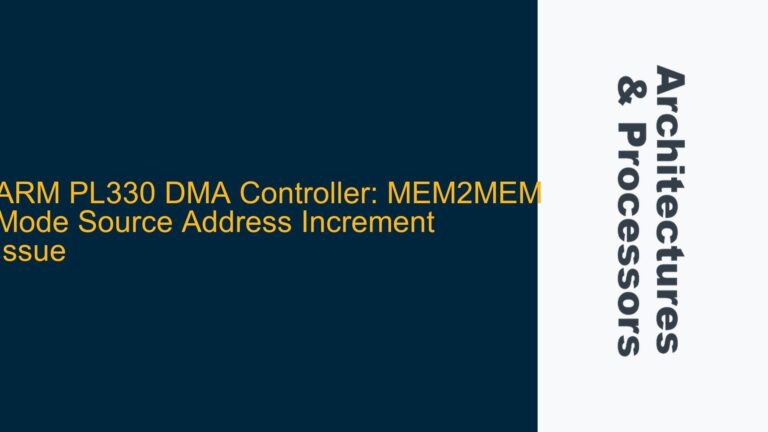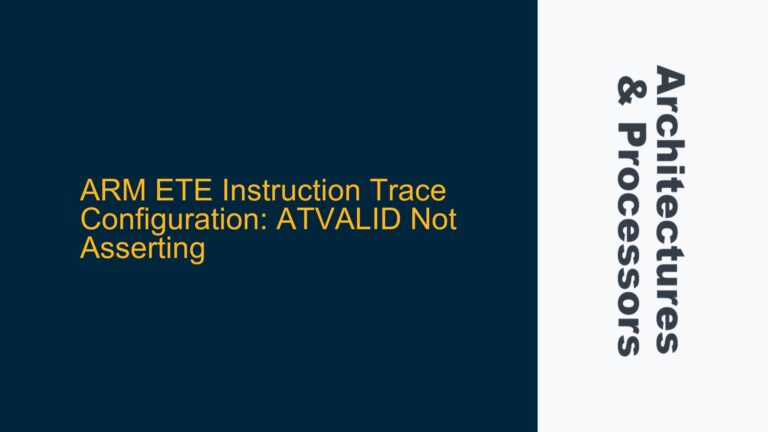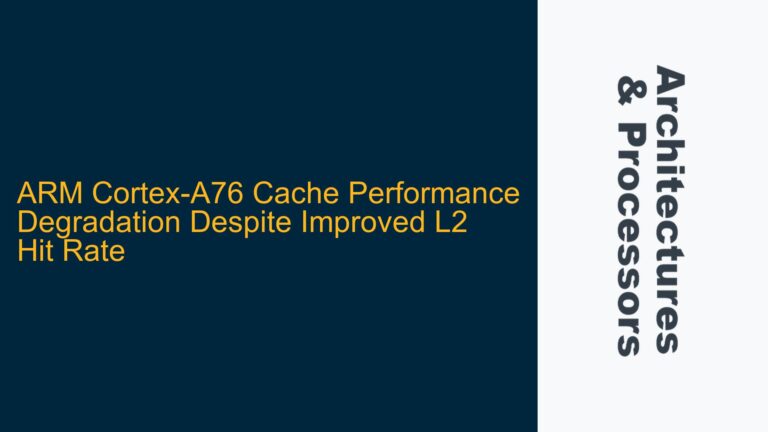Cortex-A35 Parameter Reconfiguration Challenges in System Builder and Socrates Tool
Reconfiguring parameters for the ARM Cortex-A35 processor within a System-on-Chip (SoC) design using tools like System Builder and Socrates can be a complex task, especially when documentation is sparse or unclear. The Cortex-A35 is a highly configurable processor, and its parameters—such as cache sizes, memory interfaces, and power management settings—must be carefully tuned to meet the specific requirements of the target application. System Builder and Socrates are powerful tools for this purpose, but their usage requires a deep understanding of both the tools and the underlying ARM architecture.
The primary challenge lies in navigating the toolchain to correctly identify and modify the relevant parameters. System Builder is typically used for high-level system configuration, while Socrates provides a more detailed view of the hardware-software interface. However, without proper guidance, users may struggle to locate the specific settings for the Cortex-A35, leading to suboptimal configurations or even system failures. This issue is compounded by the fact that the Cortex-A35 is often used in low-power, high-efficiency applications where even minor misconfigurations can have significant impacts on performance and power consumption.
Missing or Inadequate Documentation for System Builder and Socrates Toolchain
One of the most common issues when working with System Builder and Socrates is the lack of comprehensive, up-to-date documentation. ARM provides extensive documentation for its processors, but the tools used to configure these processors often have less detailed guides. This can leave users unsure of how to proceed, especially when dealing with advanced configurations or custom SoC designs.
The absence of clear documentation can lead to several problems. First, users may not know which parameters are configurable and how they interact with each other. For example, changing the cache size of the Cortex-A35 may require adjustments to the memory controller settings, but without proper documentation, users might overlook this dependency. Second, the tools themselves may have hidden features or undocumented behaviors that are only discovered through trial and error. This can result in wasted time and resources as users attempt to reverse-engineer the tool’s functionality.
Another issue is the potential for outdated or incorrect information. ARM frequently updates its tools and processors, but the documentation may not always keep pace. This can lead to confusion when users encounter discrepancies between the documented behavior and the actual behavior of the tools. For instance, a parameter that was once configurable in an older version of System Builder might have been moved or renamed in a newer version, leaving users to guess where it has gone.
Step-by-Step Guide to Configuring Cortex-A35 Parameters with System Builder and Socrates
To address the challenges of reconfiguring Cortex-A35 parameters using System Builder and Socrates, follow this detailed guide. The steps outlined here assume a basic familiarity with ARM architectures and the tools in question. If you are new to these tools, it is recommended to first review the available ARM documentation and tutorials to build a foundational understanding.
Step 1: Setting Up the Environment
Before diving into parameter reconfiguration, ensure that your development environment is properly set up. This includes installing the latest versions of System Builder and Socrates, as well as any necessary dependencies. ARM provides installation guides for these tools, but it is important to verify that all components are correctly installed and configured. Pay special attention to any environment variables or paths that need to be set, as these can affect the tool’s behavior.
Once the tools are installed, launch System Builder and create a new project. Select the Cortex-A35 as the target processor and specify the desired SoC configuration. This will serve as the foundation for your parameter reconfiguration efforts. At this stage, it is also a good idea to review the default settings for the Cortex-A35 to understand the baseline configuration.
Step 2: Identifying Configurable Parameters
With the project set up, the next step is to identify the parameters that can be reconfigured. System Builder provides a high-level view of the system, allowing you to modify parameters such as cache sizes, memory interfaces, and power management settings. However, not all parameters may be immediately visible, especially if they are nested within submenus or require advanced configuration modes.
To locate the relevant parameters, navigate through the System Builder interface and look for sections related to the Cortex-A35. Pay attention to any tooltips or help text that may provide additional information about the parameters. If you are unsure about a particular setting, consult the ARM documentation for the Cortex-A35 to understand its purpose and potential impact on the system.
Step 3: Modifying Parameters and Validating Changes
Once you have identified the parameters to be reconfigured, proceed to modify them according to your requirements. For example, if you need to increase the L2 cache size, locate the corresponding setting in System Builder and adjust it accordingly. Be mindful of any dependencies or constraints that may apply. For instance, increasing the cache size may require additional memory bandwidth, so ensure that the memory controller settings are appropriately configured.
After making the changes, validate them by running a system simulation or synthesis. System Builder and Socrates provide simulation tools that allow you to test the modified configuration before committing it to hardware. This step is crucial for identifying any potential issues or bottlenecks that may arise from the reconfiguration. Pay close attention to performance metrics such as latency, throughput, and power consumption, as these can provide valuable insights into the effectiveness of your changes.
Step 4: Iterative Optimization and Debugging
Parameter reconfiguration is often an iterative process, especially in complex SoC designs. After validating the initial changes, you may need to fine-tune the parameters to achieve the desired performance and power characteristics. This may involve adjusting multiple settings and running additional simulations to evaluate their impact.
During this phase, it is important to maintain detailed records of the changes made and their effects on the system. This will help you track your progress and identify any patterns or trends that may emerge. If you encounter issues or unexpected behavior, use the debugging tools provided by System Builder and Socrates to diagnose the problem. ARM’s documentation and community forums can also be valuable resources for troubleshooting and optimization.
Step 5: Finalizing the Configuration and Generating Outputs
Once you are satisfied with the parameter configuration, finalize the design and generate the necessary outputs. System Builder and Socrates can produce a variety of outputs, including RTL code, synthesis scripts, and documentation. Ensure that these outputs are correctly generated and that they reflect the intended configuration.
Before proceeding to hardware implementation, perform a final review of the configuration to verify that all parameters have been correctly set and that there are no unresolved issues. This is also a good time to document the final configuration for future reference. Once the design is finalized, you can proceed with the hardware implementation and testing.
Additional Considerations and Best Practices
When reconfiguring Cortex-A35 parameters using System Builder and Socrates, there are several additional considerations and best practices to keep in mind. First, always start with a clear understanding of the target application and its requirements. This will help you prioritize which parameters to reconfigure and ensure that the changes align with the overall design goals.
Second, leverage the simulation and debugging tools provided by System Builder and Socrates to thoroughly test the configuration before committing it to hardware. This will help you identify and resolve any issues early in the design process, reducing the risk of costly errors later on.
Finally, stay informed about updates and new features in System Builder and Socrates. ARM frequently releases updates to its tools, and these may include new capabilities or improvements that can enhance your design process. By staying up-to-date, you can take full advantage of the tools’ capabilities and ensure that your designs are optimized for the latest ARM architectures.
In conclusion, reconfiguring Cortex-A35 parameters using System Builder and Socrates is a complex but manageable task with the right approach. By following the steps outlined in this guide and adhering to best practices, you can effectively optimize your SoC design and achieve the desired performance and power characteristics.






